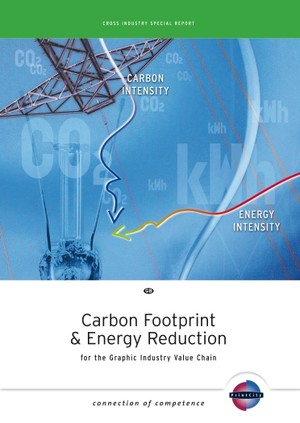Since 2009 PrintCity has amassed a large body of technical, scientific and economic research involving topics of relevance for the global printing & packaging industry. This was done together with experts from several international industry organisations to create and peer review this very special cross-industry study focusing on:
· Carbon Footprinting - how to understand and use this beneficial measurement tool
· Energy Reduction - examination of complete process chain + best practice advice
· International Harmonisation - understanding & achieving global standards harmonisation
PrintCity Alliance Carbon & Energy Report - News Headlines
From the shared ‘connection of competence’ knowledge of PrintCity members & partners, plus accredited national & international research reviewed by the PrintCity project team, we can drive greater industry confidence in the future of print in the complex multi-media world:
1. Carbon Footprints - how do they impact the print industry – Carbon Footprinting is an evaluation tool to measure the environmental impact of a product or process, primarily to facilitate the reduction of energy use and lower Green House Gas (GHG) emissions. Effective use of Carbon Footprinting will help guide capital investment, utilities, recycling and business efficiency decisions & opportunities for everyone.
The PrintCity Alliance report explains what Carbon Footprints are, how the print & packaging industry can use such knowledge and what to focus on.
2. Lean, Green & Energy are linked and mutually supportive – ‘Lean’ and ‘Green’ frequently go hand-in-hand to improve both environmental and business performance. Energy supply is limited; is expensive and it will become more expensive. Energy optimisation is key to reducing demand needs, GHG emissions and related business costs. It also creates a more efficient ‘lean’ business culture which is more environmentally effective with lower carbon & energy impact.
The PrintCity Alliance report shows the linkage between Lean & Green thinking, how the industry can become more energy efficient, and what to prioritise.
3. International Harmonisation – the problem and the solution – Current sector or national Carbon Footprinting approaches are confusing, costly and complex – they need to be clear, concise and credible for everyone to understand. A harmonised international approach to applying Carbon Footprinting across all elements of the graphics industry value chain is required.
The PrintCity report overviews international standards and highlights how global harmonisation is progressing with the ClimateCalc Consortium and the ISO 14067 standards development.
4. Paper has a strong future in a multi-media world – Print is not always perceived by consumers as being environmentally friendly but it is the only media with a one-time carbon footprint – all other media require energy every time they are looked at.
Research by Gartner indicates the pulp, paper and printing industry uses around 1% of total global energy, whereas Internet Data Centres alone use about 4% of the global total.
This comparison does not factor in the significant power & emissions impact of all the ‘receiving’ electronic devices (smart phones, tablets, laptops and home/office PCs). Energy use for electronic media is growing each year, whereas it is stable for the printing industry, which is becoming more energy and carbon efficient.
In the future, both electronic & print media will have strong roles to play in society. Both media should live together, be linked where possible and enrich each other.
The PrintCity report highlights the strong role that print should play in a constantly changing multi-media society. Print is of high value and positive environmentally!
This new PrintCity Alliance Carbon Footprint & Energy Reduction report is the broadest print & packaging multi-company and multi-partner project in this increasingly important and complex subject area. This new environmental report follows the highly successful first publications by the alliance - Sustainability, Energy and the Environment plus Energy Efficiency Optimisation for Web Offset Printers.
Carbon Footprint & Energy Reduction for the Graphics Industry Value Chain is an important new industry reference document. Other alliance research in the environmental area is planned for the following years.
Why? How? What? A printer and converter practical guide for Carbon Footprinting & Energy Reduction
Why? How? What? A printer and converter practical guide for Carbon Footprinting & Energy Reduction
Article ID:
13252
New PrintCity Report
Gröbenzell, Germany, April 28, 2010 – PrintCity Alliance members Kurz, m-real, manroland, MKW, Sappi, Sun Chemical, Trelleborg and UPM, plus project partner Muller Martini have now published their new Carbon Footprint & Energy Reduction for the Graphic Industry Value Chain special report. The purpose of this new PrintCity 32-page guide is to facilitate the improved collaborative environmental performance of printers, converters, publishers, brand owners and their suppliers. It is available in printed form from any participating company, or from www.printcity.de/shop at ‘no cost’.

Attachments
Related Articles
-
2020-10-15 10:21
-
2020-10-15 09:50
-
2020-10-15 08:21
-
2020-10-14 10:49
-
2020-10-12 09:49


